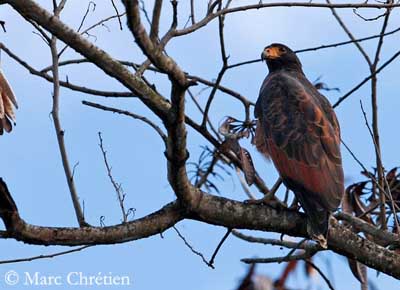
Rufous Crab-Hawk
Buteogallus aequinoctialis
Accipitriforme Order – Accipitridae Family
BIOMETRICS:
Length : 43-46 cm
Weight : M : 600 g – F : 800 g
DESCRIPTION:
The Rufous Crab-Hawk is a beautiful bird of prey, common on the Atlantic coast of north-eastern South America.
Adult male has blackish upperparts, with conspicuous rufous edges on wings and back. Flight feathers are rufous with blackish tips.
The tail is black and shows two narrow white bands, one median band and one terminal band.
On the underparts, the plumage is dark rufous with fine paler barring. Undertail coverts show fine white bars.
The head, throat and nape are sooty-brown, as the upper back. The bare facial skin, eye-ring and cere are orange-yellow. The bill is horn-coloured with black hooked tip. The eyes are brown. Legs and talons are orange-yellow.
Female is similar but larger than male.
Fr: Buse buson
All: Rotbauchbussard
Esp: Busardo-negro del Atlántico
Ital: Poiana rossiccia cancrivora
Nd: Krabbenbuizerd
Russe: Крабовый чёрный канюк
Port: Gaviao-caranguejeiro
Photographs by Patrick Ingremeau
TAMANDUA
Photographs by Marc Chrétien
MURINUS
Text by Nicole Bouglouan
Sources :
HANDBOOK OF THE BIRDS OF THE WORLD Vol 2 by Josep del Hoyo-Andrew Elliot-Jordi Sargatal - Lynx Edicions - ISBN: 8487334156
L’ENCYCLOPEDIE MONDIALE DES OISEAUX - Dr Christopher M. Perrins - BORDAS - ISBN: 2040185607
Birds of Northern South America, an identification guide by Robin Restall, Clemencia Rodner, Miguel Lentino - Helm field guides - Christopher Helm, London - ISBN: 0713672420 (1)
Birds of Northern South America, an identification guide by Robin Restall, Clemencia Rodner, Miguel Lentino - Helm field guides - Christopher Helm, London - ISBN: 0713672439 (2)
OISEAUX DE GUYANE by Olivier Tostain, Jean-Luc Dujardin, Christian Erard et Jean-Marc Thiollay - S.E.O (Société d'études ornithologiques) - ISBN: 2950654800
PORTRAITS D’OISEAUX GUYANAIS - Groupe d'étude et de protection des oiseaux en Guyane (GEPOG) - Ibis rouge éditions - ISBN: 2844501842

The immature has brown upperparts, with darker streaks, spots and bars. The tail is greyish with darker bands.
The underparts are white with dusky streaks, mainly on throat and upper breast. On the underwings, the flight feathers are brownish with whitish bars and darker tips. The thighs are barred too.
Facial skin and cere are pale yellowish. Bill is whitish-grey. Eyes are brown. Legs and feet are yellowish.
VOICE: SOUNDS BY XENO-CANTO
Rufous Crab-Hawk utters melodious whistles, relatively loud, which allow detecting the bird. We can also hear several laughing notes fairly musical.
HABITAT:
Rufous Crab-Hawk frequents estuaries and coastal mangroves, marshy coastal areas, but it may also be found in wet savannahs and along rivers.
RANGE:
Rufous Crab-Hawk lives in the north-eastern coasts of South America, in Brazil, the Guianas, Trinidad and Tobago and Venezuela.
BEHAVIOUR:
Rufous Crab-Hawk is usually seen alone or in pairs. It is often perched on exposed branch near water, and its melodious whistle helps for detecting it.
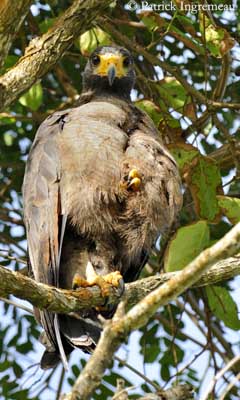
It feeds only on crabs, caught from a perch. The Rufous Crab-Hawk catches the crab at the burrow’s entrance. Then, it brings its prey on stumps, low branches or on dry parts of the ground to eat the crab after shelling. It is also able to hunt on the wing, flying low over the mudflats.
The Rufous Crab-hawk is sedentary in its range.
During the breeding season, it performs flight displays and vocalizations.
FLIGHT:
The Rufous Crab-Hawk flies low over the mudflats for hunting. Its broad wings allow the bird an effortless flight.
REPRODUCTION:
Breeding season usually occurs in rainy season. In Suriname, it occurs from February to June.
The nest is usually situated in tree, mainly in mangroves. It is a small platform made with sticks in a fork of the tree. The interior is lined with leaves. The nest is often built high in tree, at about 15 to 25 metres above the water.
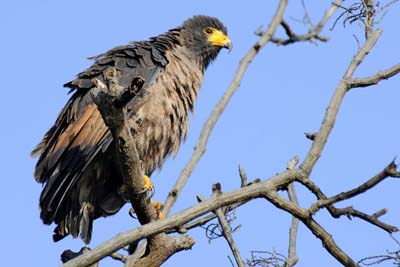
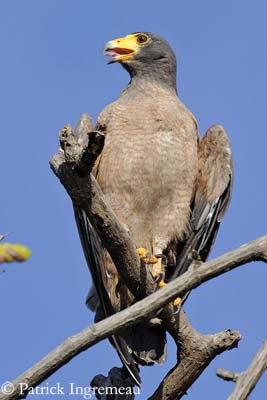
Female usually lays one egg, sometimes two.
The nesting behaviour of the Rufous Crab-Hawk is poorly known. Usually, these raptors have an incubation period which lasts from 21 to 60 days, and the chick remains at nest for 45 to 100 days before fledging.
The young is usually fed by both parents.
DIET:
The Rufous Crab-Hawk feeds exclusively on crabs, taken at burrow’s entrance. It hunts from a perch or on the wing.
It shells its prey with the bill, by removing the shell thanks to its strong, hooked bill.
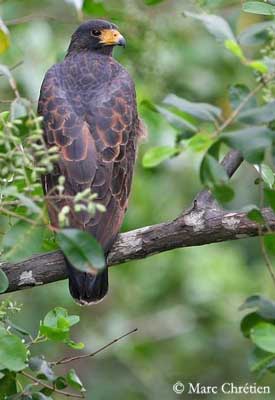
PROTECTION/THREATS/STATUS:
Rufous Crab-Hawk is common in mangroves within its habitat. At this moment, this species is not threatened, but the restricted habitat may suffer degradation in next future, causing the loss of this particular habitat.